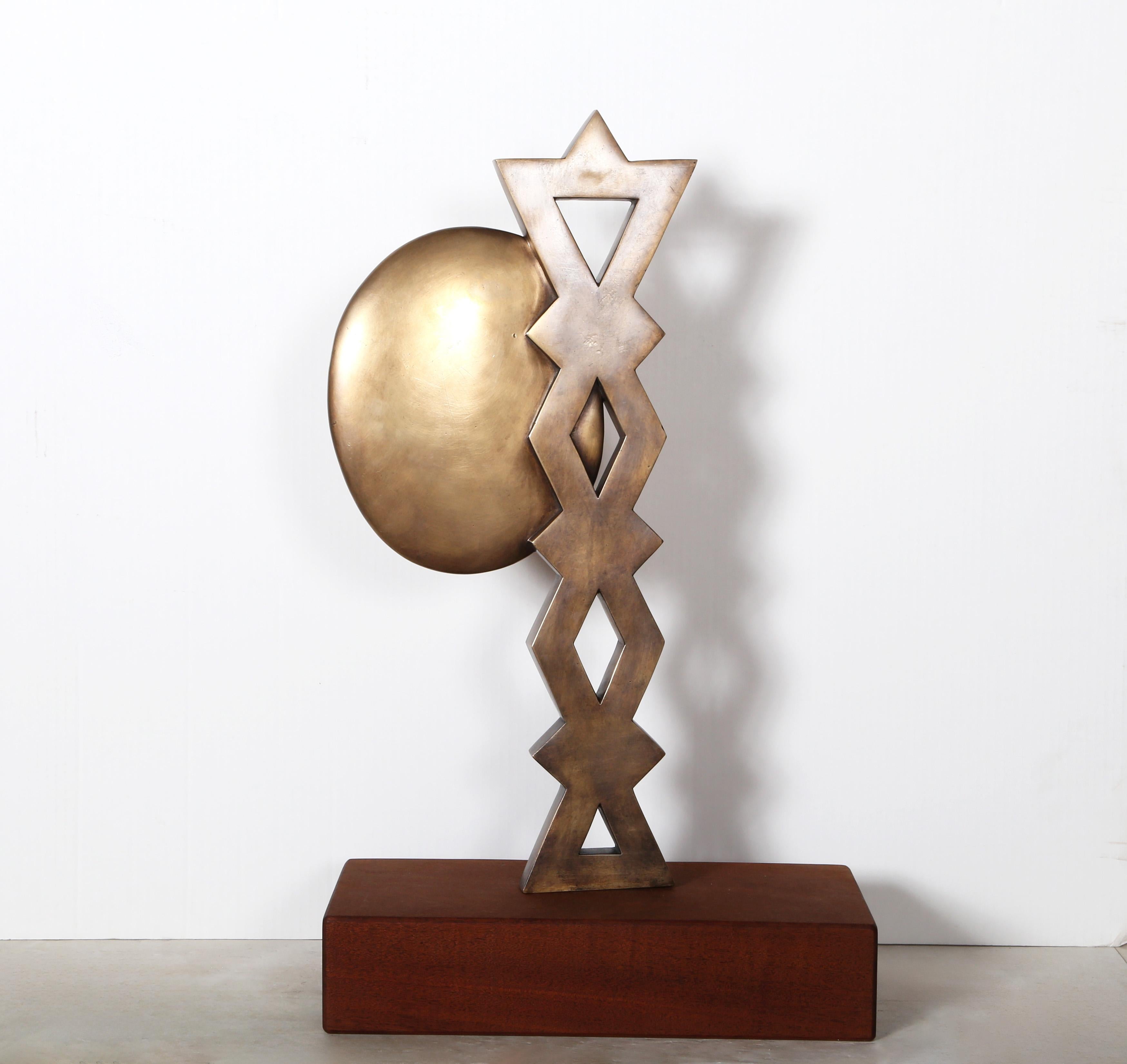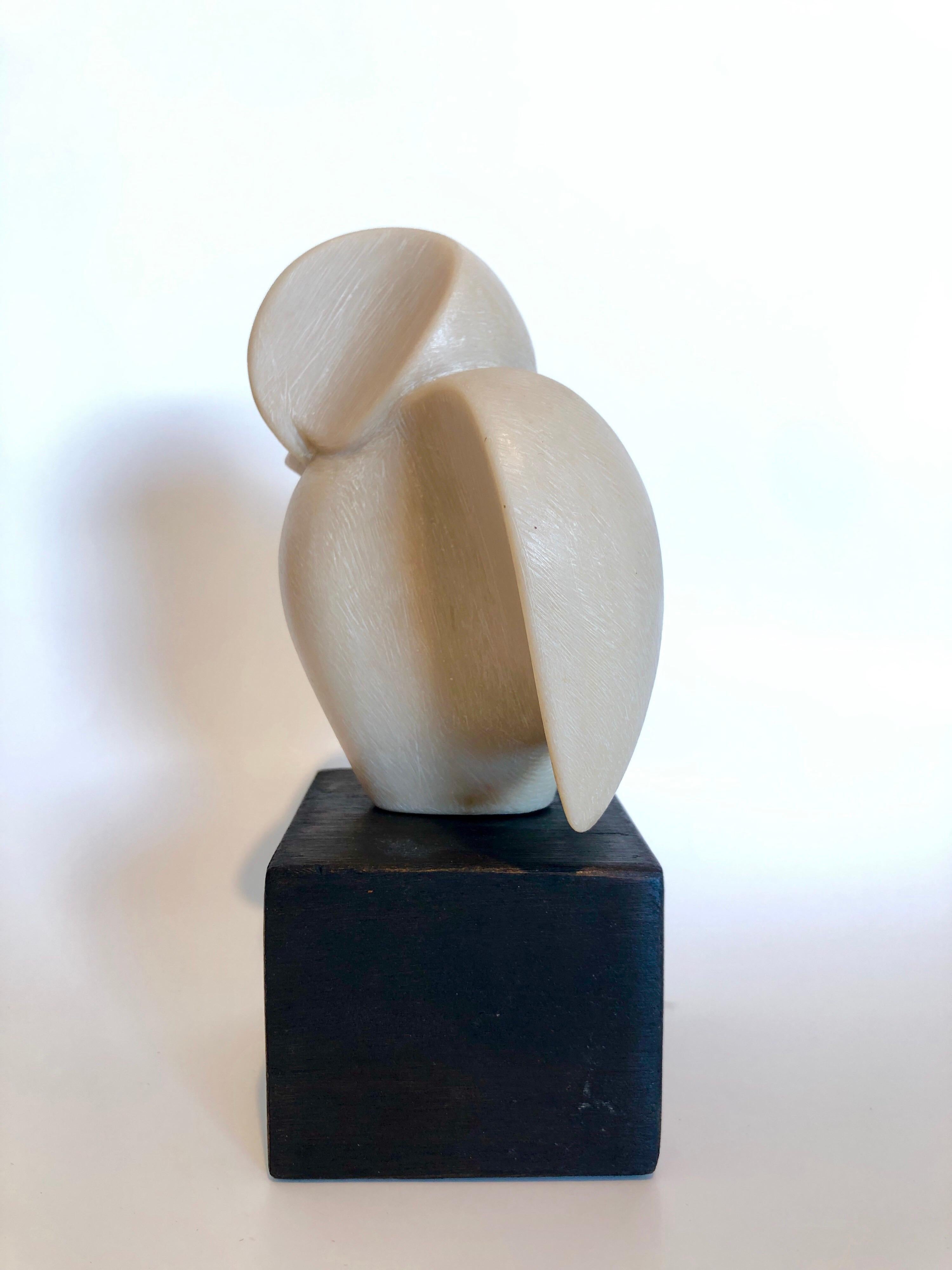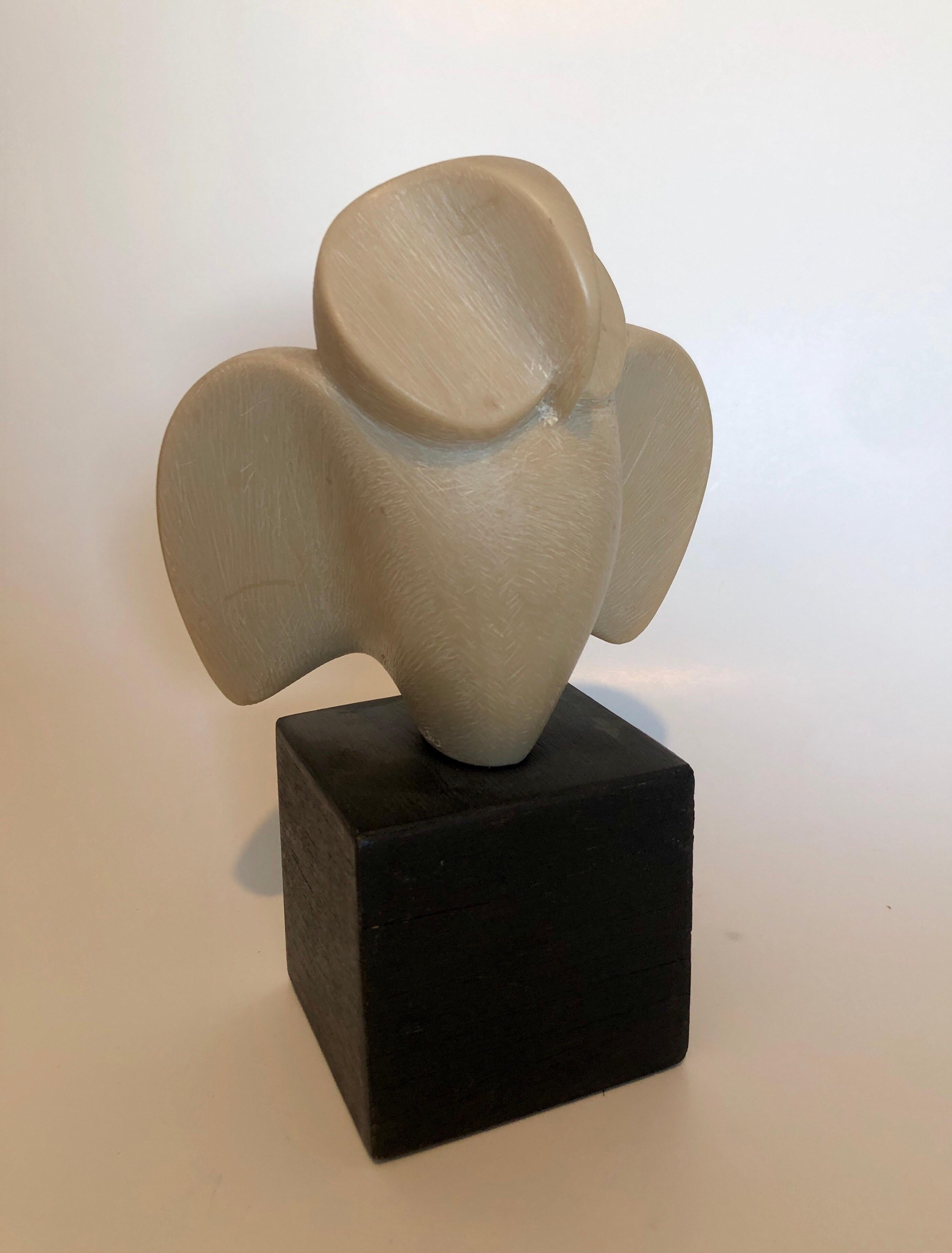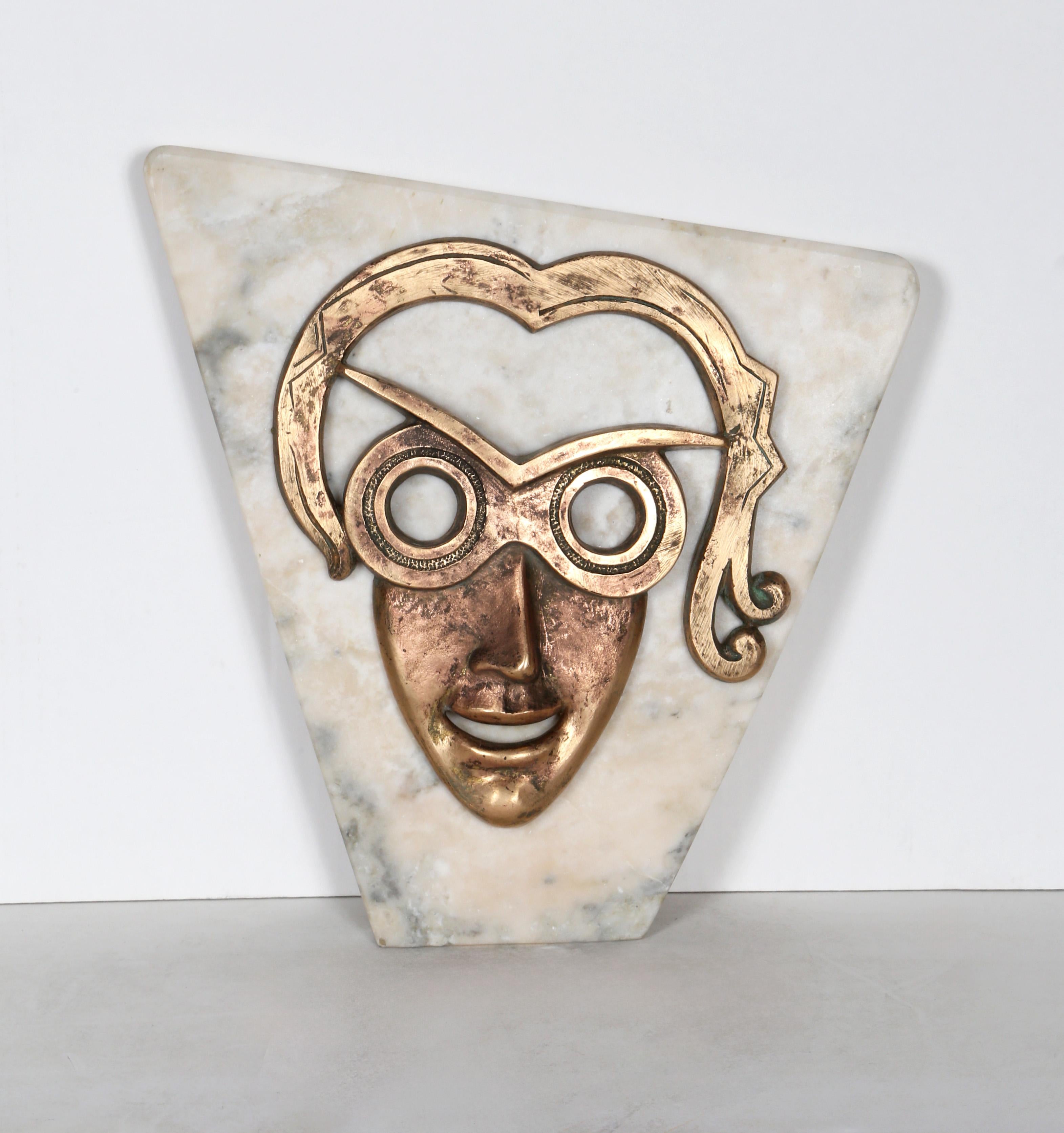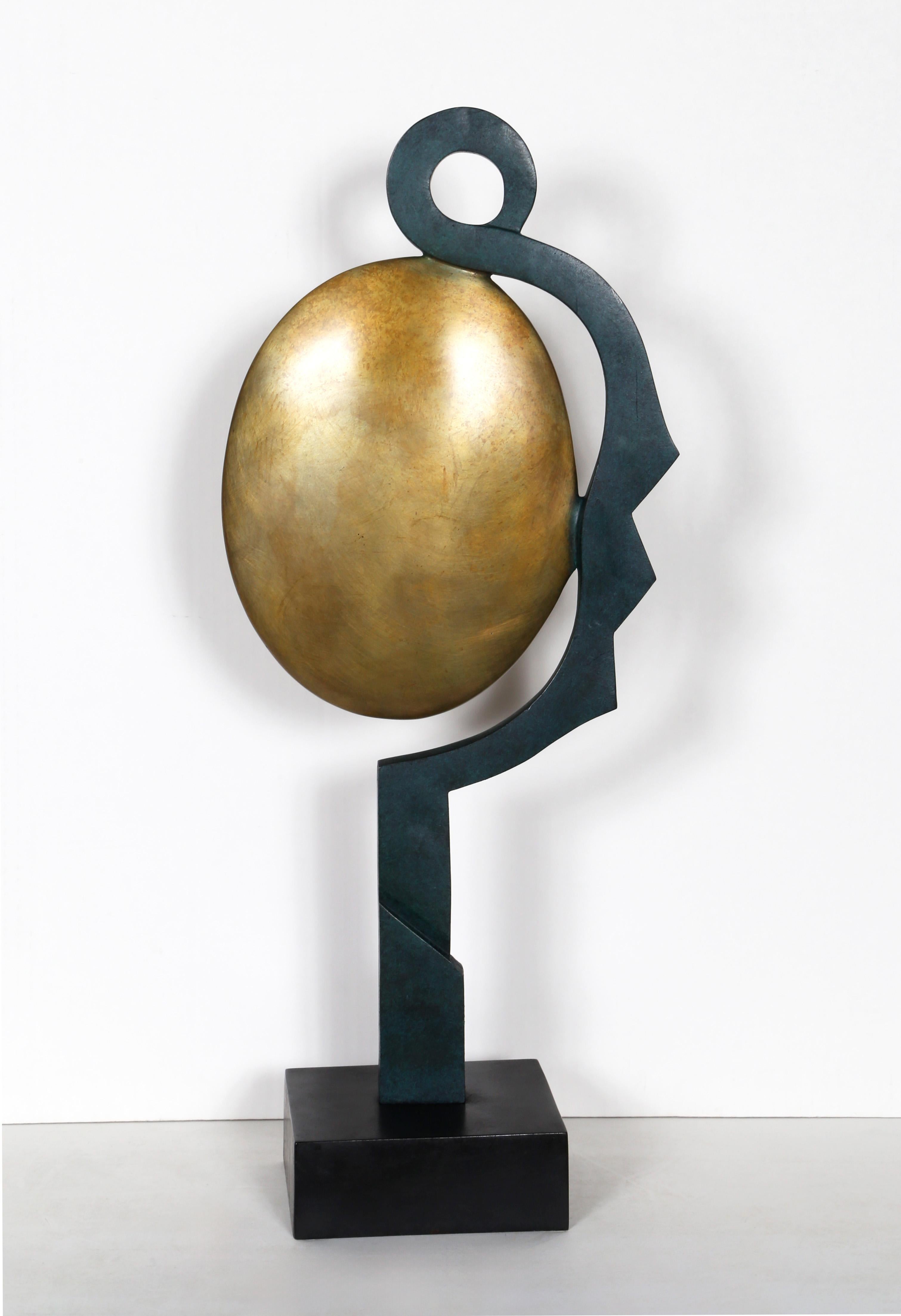Items Similar to Cuban Master Florencio Gelabert Sculpture Large Wood Carving Bust Man Portrait
Want more images or videos?
Request additional images or videos from the seller
1 of 21
Florencio GelabertCuban Master Florencio Gelabert Sculpture Large Wood Carving Bust Man Portrait1979
1979
About the Item
Florencio Gelabert Y Perez (Cuban, 1904-1995)
Hand carved, signed; 1979
Materials: Cuban wood (mahogany?)
Dimensions 23 X 4 X 4 inches
Label affixed to underside: National Registry of Cultural Assets of the Republic of Cuba Ministry of Culture.
Provenance: Art Master Collection, Miami, Florida.
Florencio Gelabert, with a style reminiscent of Art Deco and Art Nouveau in a Latin American Expressionist stylization. Carved wood sculpture. Depicts a modernist stylized form of a man in a streamline moderne style.
José Florencio Gelabert Pérez (Caibarien, 1904 - Havana, 1995) Cuban musician, sculptor, draftsman and teacher. He graduated from the San Alejandro National Academy of Fine Arts in 1934. He received numerous awards, mentions and recognitions in Fine Arts Halls and Circles. His works are in the permanent collection of the National Museum of Fine Arts. Florencio Gelabert is a renowned sculptor, who made more than twenty solo exhibitions beginning in 1929, several in the National Museum of Fine Arts, and participated in more than thirty collectives in Cuba, Spain and Brazil, the latter in the Sao Paulo Biennial. he traveled from Caibarién to Santa Clara in 1928 to audition to enter the famous San Alejandro Fine Arts School in Havana. He obtained one of the five vacancies. Already in the Cuban capital, he combined fine arts and music. When he graduated, he became a professor in San Alejandro and the academy’s principal in 1960.
With a calling common to wood sculptors –which began with his primary school carving carpentry classes and the active life of his home town’s shipyards, his chisels and gouges feverishly turned mahogany, “ácana” and ebony into female heads with black African features dating back to 1930.
In 1938 he used his savings to explore Europe: France (Paris, Marseilles), Italy (Naples, Rome, Florence, and Venice), Belgium (Malina). His encounter with the works by Aristide Maillol, Auguste Rodin, Ossip Zadkine, Constantin Brancusi and even with Wifredo Lam, who was also born in another Cuban coastal area, Sagua la Grande, and his encounter with the nude marble David sculpture by Michelangelo all marked important points in his artistic development.
Following his European journey, his Carribean roots seemed intact. Technique filled his senses. “It was like planting ideas”, said the artist years later.
Gelabert traveled to the United States (New York, Washington, Philadelphia) in 1940. There he discovered the incalculable values of the concrete which covered large skyscrapers. Later, he was certain that the material could be used to make sculptures. Years later he lived in Mexico, where he met muralist Jose Clemente Orozco and held a personal exhibit at the Fine Arts Palace with 40 works, some of which made with the lost wax technique that he learned in the Latin American nation. The Riviera Hotel in 1957 allowed the artist to give free reigns to his imagery and show how beautiful sculptures could be made of concrete, though he preferred to make a series of bronze figures for the facility’s lobby. With the ocean as fiercely background, Gelabert designed a series of sculptures for the hotel’s entrance: a sea-horse, a nymph, a shark, dolphins, made of highly resistant direct concrete. He created La Velocidad (Speed), which decorates the entrance to Havana’s Bus Station; the Atlantico Hotel’s fountain in Santa Maria del Mar beach; the immense crab at the entrance to his hometown of Caibarién; the large mural made of pieces of marble in the convergence of Primelles and Santa Catalina streets in the Cuban capital.
José Florencio Gelabert Pérez (Caibarién, 23 de febrero de 1904-La Habana, 30 de agosto de 1995) Músico, escultor, dibujante y profesor cubano. Se graduó en la Academia Nacional de Bellas Artes San Alejandro en 1934. Recibió numerosos premios, menciones y reconocimientos en Salones y Círculos de Bellas Artes. Obras suyas se encuentran en la colección permanente del Museo Nacional de Bellas Artes. Florencio Gelabert es un escultor de reconocimiento.Realizó más de veinte exposiciones personales desde la temprana fecha de 1929, varias en el Museo Nacional de Bellas Artes, y participó en más de treinta colectivas en Cuba, España y Brasil, en este último en la VI Bienal de Sao Paulo.
Of the generation of Cuban Masters Wifredo Lam, Agustin Cardenas, Manuel Mendive, Sandu Darie, Agustin Fernandez, Jose Mijares, Amelia Pelaez, Mariano Rodriguez, Lolo Soldevilla and Rafael Soriano. He has been shown in the finest expositions and museums devoted to Cuban Art.
- Creator:Florencio Gelabert (1904 - 1995, Cuban)
- Creation Year:1979
- Dimensions:Height: 23 in (58.42 cm)Width: 4 in (10.16 cm)Depth: 4 in (10.16 cm)
- Medium:
- Movement & Style:
- Period:
- Condition:minor wear commensurate with age. please see photos.
- Gallery Location:Surfside, FL
- Reference Number:1stDibs: LU38212429602
About the Seller
4.9
Platinum Seller
These expertly vetted sellers are 1stDibs' most experienced sellers and are rated highest by our customers.
Established in 1995
1stDibs seller since 2014
1,559 sales on 1stDibs
Typical response time: 1 hour
- ShippingRetrieving quote...Ships From: Surfside, FL
- Return PolicyA return for this item may be initiated within 3 days of delivery.
More From This SellerView All
- Czech Art Deco Carved Natural Resin Cubist Owl Bird Sculpture Joseph MartinekLocated in Surfside, FLAmerican sculptor Joseph Martinek was born in Chicago in 1915. He was a second generation apprentice to Auguste Rodin. He studied sculpture at the State Industrial School of Art, Pra...Category
20th Century Art Deco Figurative Sculptures
MaterialsResin, Wood
- Czech Art Deco Carved Natural Resin Cubist Owl Bird Sculpture Joseph MartinekLocated in Surfside, FLAmerican sculptor Joseph Martinek was born in Chicago in 1915. He was a second generation apprentice to Auguste Rodin. He studied sculpture at the State Industrial School of Art, Pra...Category
20th Century Art Deco Figurative Sculptures
MaterialsResin, Wood
- Czech Art Deco Carved Natural Resin Cubist Dove Bird Sculpture Joseph MartinekLocated in Surfside, FLAmerican sculptor Joseph Martinek was born in Chicago in 1915. He was a second generation apprentice to Auguste Rodin. He studied sculpture at the State Industrial School of Art, Pra...Category
20th Century Art Deco Figurative Sculptures
MaterialsResin, Wood
- Blas Castagna Hand Painted Wooden Constructivist Sculpture Toy Horse Carved WoodLocated in Surfside, FLBlas Alfredo Castagna was born in Buenos Aires, Argentina in 1935. He studied at the Manuel Belgrano National School of Fine Arts and at the Prilidiano Pueyrredón School, where he obtained the title of National Professor of Drawing and Decorator Painter. In 1959 he traveled to Italy and in Sicily he attended the metal-beating workshop at the Scuola d´Arte di Comiso. A year later, he had a solo show of oil painting and gouaches at the “Alcora” Gallery in Buenos Aires, also presenting it in the province of San Juan. In addition to his artistic activity, he worked between 1974 and 1976 as a teacher in the Department of Plastic Arts, Faculty of Humanities, of the National University of San Juan. In 1982 he was invited to exhibit plates and monotypes at the Galerie de L´Université - Tour Mauran in Toulouse, France. A year later he exhibited in our country at the Van Riel Gallery, where a long connection with this room begins. In 1998 he exhibited again in Toulouse, at the Espace Croix Baragnon, an exhibition entitled "Origins, Mémoide", also presenting that year, at the Enrique Larreta Museum of Spanish Art in Buenos Aires, his "Obra Figurativa 1973-1993". Collectively, he presents his works in Uruguay, Cuba, Spain, at the Museum of Modern Art in Buenos Aires and at the National Museum of Fine Arts, at the Borges Cultural Center (2007 and 2008), at the Museum of Modern Art in Bahia ( Brazil, 2005), at the Sainsbury Center Norwich (United Kingdom, 2004), Centro Cultural Recoleta (1999), at the Fortabat Foundation (1985), at the II Biennial of Havana (1986) and at the ARCO fair in Madrid ( 1987). In 1990 he was awarded the Spirit of Greece Award for engraving, and in 1992 the “Konex Platinum Award. His work is influenced by the Latin American geometric constructivism present in Argentina and Uruguay as well as the European influences of Surrealism and Dada Art. He showed at the prestigious van Riel Gallery. For over 80 years the Frans van Riel Gallery has exhibited at the forefront of Argentinean art. Beginning with Alfredo Hlito “Grupo de Artistas Modernos de la Argentina” (Argentinian Modern Artists). The avant-garde of the 1950s and the work of Kenneth Kemble, Leónidas Gambartes and the Grupo Litoral, Juan Del Prete, Aldo Paparella sculpture, Julio Llinás, Aldo Pellegrini, Juan Batlle Planas, Libero Badii, Malena Babino, Horacio Butler, Alejandro Corujeira, Juan Del Prete, Kirin, Luis Felipe Noé...Category
20th Century Neo-Constructivist Figurative Sculptures
MaterialsFabric, Wood, Paint
- Abstract Geometric Cubist Painted Wood Sculpture Head Italian Neo Figurative ArtBy Italo ScangaLocated in Surfside, FLThis painted wood assemblage sculpture by Italo Scanga, epitomizes the characteristics of his oeuvre. Polychrome head portrait bust. This was signed on a brass or bronze plaque but that has gone missing. It is unsigned. I believe there might be a studio stamp on the bottom. Italo Scanga (June 6, 1932 - July 7, 2001), an Italian-born American artist, was known for his sculptures, prints and, paintings, mostly created from found objects. In his youth in Calabria, Italy he worked as a cabinetmaker's apprentice and studies sculpture with a man who carved statues of saints. Italo Scanga was an innovative neo Dada, neo-Expressionist, and neo-Cubist multimedia artist who made assemblage, collage, sculptures of ordinary objects and created prints, glass, and ceramic works. Modern Italian abstract geometric folk art. Scanga's materials included natural objects like branches and seashells, as well as kitsch figurines, castoff musical instruments and decorative trinkets salvaged from flea markets and thrift shops. He combined these ingredients into free-standing assemblages, which he then painted. Although visually ebullient, the results sometimes referred to gruesome episodes from Greek mythology or the lives and deaths of martyred saints. He considered his artistic influences to be sweepingly pan-cultural, from African sculpture to Giorgio de Chirico. He often collaborated with the sculptor Dale Chihuly, who was a close friend. Constructed of wood and glass, found objects or fabric, his ensembles reflect a trio of activities—working, eating, and praying. These activities dominate the lives of those who live close to the land, but they are also activities that are idealized by many who contemplate, romantically, a simpler, bucolic life. Italo graduated from Michigan State University where he befriended fellow artists Richard Merkin and David Pease. He studied under Lindsey Decker who introduces him to welding and sculpture after his initial interest in photography. Also studies with Charles Pollock, the brother of Abstract Expressionist Jackson Pollock. His first teaching job was at University of Wisconsin (through 1964). where he met Harvey Littleton, a fellow instructor. He later moves to Providence, Rhode Island,I to teach at Rhode Island School of Design (RISD). Is colleagues with artists Richard Merkin and Hardu Keck. Starts a correspondence with HC Westermann. Spends summers teaching at Brown University; colleague of Hugh Townley. Moves to State College, PA, and teaches at Pennsylvania State University for one year. Meets artists Juris Ubans, Harry Anderson, Richard Frankel, and Richard Calabro, who remain friends throughout his career. 1967: David Pease helps him get a tenure track position at Tyler School of Art in Philadelphia, PA, . Artists he works closely with include Ernest Silva, Lee Jaffe, Donald Gill, and William Schwedler. Meets graduate student Dale Chihuly while lecturing at RISD and develops a lifelong friendship. 1969: One person exhibition, Baylor Art Gallery, Baylor University, Waco, TX. Works very closely with students Larry Becker and Heidi Nivling (who later run a gallery in Philadelphia, PA), and Harry Anderson. Welcomes many artists into his home including Donald Judd, Dan Flavin, Bruce Nauman (a former student), Vito Acconci, Ree Morton and Rafael Ferrer. 1973: "Saints Glass" at 112 Greene Street Gallery, NYC. Installation at the Institute of Contemporary Art at University of Pennsylvania, Philadelphia, PA. Meets Gordon Matta Clark and contributes to an artist cookbook. Goes to Pilchuck Glass School, Stanwood, WA, founded by Dale Chihuly, as a visiting artist. He continues to work there annually through 2001. Works over the years with Pilchuck artists Richard Royal, Seaver Leslie, Jamie Carpenter, Joey Kirkpatrick, Flora Mace, Robbie Miller, Billy Morris, Buster Simpson, Toots Zynsky, Howard Ben Tre...Category
1980s Cubist Abstract Sculptures
MaterialsWood, Oil
- Bronze Sculpture Abstract Brutalist Goat or Ram WPA Artist Mounted on BaseBy Benedict Michael TattiLocated in Surfside, FLBenedict Tatti (1917-1993) worked in New York city as a sculptor, painter, educator, and video artist. He studied stone and wood carving under Louis Slobodkin at the Roerich Museum. He later attended the Leonardo da Vinci School of Art studying under Attilio Piccirelli. In l939 he taught adult classes with the Teachers Project of the WPA and attended the Art Students League for three and a half years on full scholarship. He studied under William Zorach and Ossip Zadkine and later became Zorach’s assistant. Later in his career, he attended the Hans Hofmann School of Fine Arts. During World War II, Tatti served in the United States Army Air Force, where he spent three years assigned to variety of projects. In 1948, Benedict Tatti married Adele Rosenberg in New York City. Throughout his career, Tatti continuously experimented with various media. From 1952-1963, Tatti executed sculptural models of architectural and consumer products for the industrial designers, Raymond Loewy Associates; later he became a color consultant for the firm. In the 1960s, influenced by the Abstract Expressionists, Tatti turned from carving directly in wood and stone to creating assemblage architecture sculptures, using bronze metal and other industrial materials. He was included in the important show "Aspects de la Sculpture Americaine", at Galerie Claude Bernard Paris, France, in October 1960 along with Ibram Lassaw, Theodore Roszak, David Smith, Louise Bourgeois, Danese Corey, Dorothy Dehner, Lin Emery...Category
Mid-20th Century Abstract Expressionist Abstract Sculptures
MaterialsBronze
You May Also Like
- Pony Tail Girl, Bronze Sculpture by Constantin AntonoviciBy Constantin AntonoviciLocated in Long Island City, NYReferenced in Uricariu & Bulat "Antonovici" on page 134, this bronze sculpture by Constantin Antonovici plays on a common shape composition of the artist's practice. At their core, t...Category
1970s Art Deco Abstract Sculptures
MaterialsBronze
- Ileana, Bronze and Marble Sculpture by Constantin AntonoviciBy Constantin AntonoviciLocated in Long Island City, NYThis Bronze portrait by Constantin Antonovici is laid directly into the surface of a cut slab of white marble. Intense and hollow eyes stare out from a smiling visage, creating an un...Category
1970s Art Deco Abstract Sculptures
MaterialsMarble, Bronze
- Pony Tail Girl, Bronze Sculpture by Constantin AntonoviciBy Constantin AntonoviciLocated in Long Island City, NYReferenced in Uricariu & Bulat “Antonovici” on page 133, this bronze sculpture by Constantin Antonovici plays on a common shape composition of the artist’s practice. At their core, t...Category
1970s Art Deco Abstract Sculptures
MaterialsBronze
- Carmen, Washington: Plaster Sculpture with Marble Base by Constantin AntonoviciBy Constantin AntonoviciLocated in Long Island City, NYA minimalist depiction of a woman in a large hat by Constantin Antonovici. This white marble sculpture is composed almost entirely of two colliding ovals, with a few ridges visible o...Category
1970s Art Deco Abstract Sculptures
MaterialsMarble
- Three Graces, Bronze Sculpture by Constantin AntonoviciBy Constantin AntonoviciLocated in Long Island City, NYThe three graces are described in Greek Mythology as the deification of beauty. These three sisters' role was to attend to the Olympians during feasts and other celebrations. Atonovi...Category
1950s Art Deco Abstract Sculptures
MaterialsBronze
- Bronze Eve - Contemporary Bronze Portrait sculpture, 2015Located in PARIS, FRSculpture en bronze sur socle par l'artiste Pascale Hamelin. Pascale Hamelin est une sculptrice française. Ses visages et ses formes racontent le souv...Category
21st Century and Contemporary Art Deco Abstract Sculptures
MaterialsBronze
Recently Viewed
View AllMore Ways To Browse
Signed Wood Sculpture
Wood Turned Art
Wood Man
Wood Sculpture Large
Large Make Sculpture
Large Vintage Wood Signs
Wood Carving Vintage
European Wood Sculpture
Large Head Sculpture
Mexican Wood Sculpture
French Wood Carving
Wood Carving French
Wood Head Sculpture
Sculpture In Art Nouveau
Art Deco Man
Italian Wood Carving
Turned Wood Sculpture
French Art Nouveau Sculpture
